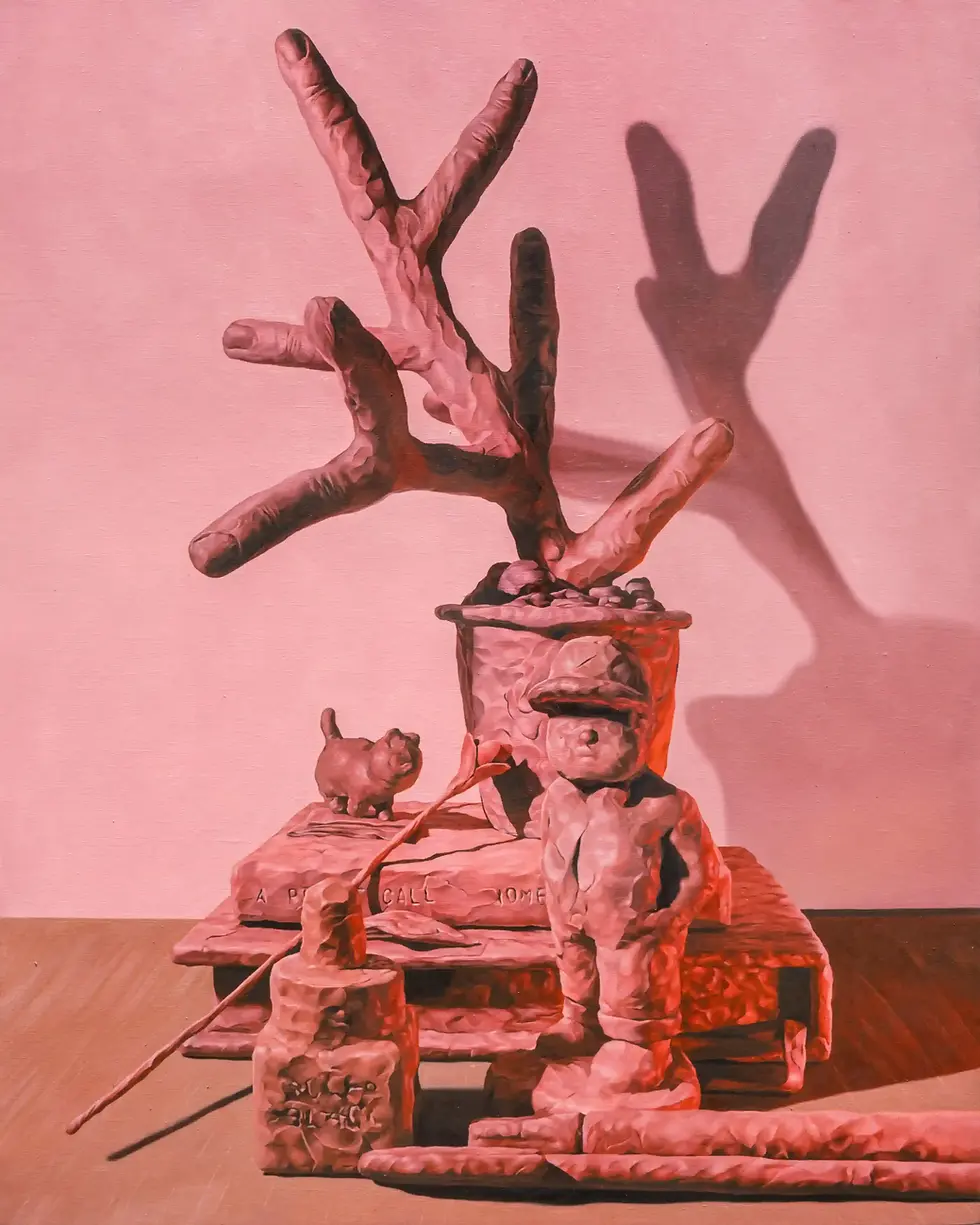Wimo Ambala Bayang
[Foot Step Approach]
27 September - 2 November 2025
kohesi Initiatives is pleased to present [Foot Step Approach], Wimo Ambala Bayang's second solo exhibition with the gallery. Over the past twenty years, Wimo has become a distinctive voice in contemporary Indonesian photography, pushing and interpreting the medium in unexpected ways.
“[Foot Step Approach]”—a phrase laden with enigma—comes from Wimo’s personal notebook. A pair of verso–recto pages in that book is almost entirely fi lled with dense black strokes that coalesce into a thick, dark fi eld. At the bottom of the page, the phrase—bracketed by two square boxes—appears inscribed in a lighter tone. The phrase was deliberately chosen as the exhibition title not only because the drawing on that page is one of the materials Wimo has reinterpreted as a new work, but also because it functions, in signifi cant measure, as a kind of fulcrum for the curatorial reading of the exhibition as a whole.
Within this curatorial framework, footstep becomes a metaphor for three key concepts—trace, movement, and temporality. These three notions bind the works together while also re-polemicizing, from a post-Benjaminian vantage, the antagonistic relation between aura and reproducibility. Approach, meanwhile—a term whose semantic doubleness is acknowledged from the outset, oscillating between “approach” as conceptual method (a guide to thinking) and “approaching” as literal action (a mode of doing)—operates as a poetic disposition, even a poetic fi guration, in which the metaphor of the “footstep” is grasped both as a way of thinking and a way of acting.
The exhibition marks a pivotal moment in Wimo’s artistic journey, as he re-examines his archive and practice, exploring the discourse of the image and its modes of production, encompassing both image-making and image-generating. The constellation of works on view—ranging from photographic series, painting series, and mural interventions to sonic compositions and video—articulates a spectrum of artistic strategies that signal, target, and interrogate the nature of the refl exive understandings available to us with regard to contemporary visual culture, as well as the institutional mechanisms of contemporary art that at once populate and shape that culture. [Foot Step Approach] extends Wimo’s long-standing engagement with the politics of images, their circulation, and their cultural signifi cance.
Frieze Seoul 2025
Art Fair
3 September - 6 September 2025
kohesi Initiatives is delighted to announce that its presentation of Timoteus Anggawan Kusno in the Focus Asia section of Frieze Seoul 2025 has been awarded the FOCUS ASIA STAND PRIZE. This marks the gallery’s debut at the fair, with its presentation on view at Booth F10. Frieze Seoul takes place from 3–6 September 2025.
Focus Asia is a section dedicated to solo presentations by galleries established in or after 2013 and based in Asia. For the 2025 edition, the jury comprises Alex Jen, Hyo Gyoung Jeon, and Jae Seok Kim. Focus Asia is presented in collaboration with Stone Island, who provide subsidies that help enable young galleries’ participation in the fair, alongside Frieze’s existing support.
kohesi Initiatives and Timoteus Anggawan Kusno are the recipients of the third iteration of this award, joining previous winners: Tokyo-based gallery Parcel with Chinese artist Lu Yang (2024), and Seoul-based gallery CYLINDER with South Korean artist Sinae Yoo (2023).
***
Timoteus Anggawan Kusno’s presentation probes the fault lines between memory, myth, and manufactured history by using the language of cinema to explore how absence itself can become a narrative force. Set against the backdrop of Indonesia’s turbulent 1960s, a time marked by political rupture, mass censorship, and the violent reordering of cultural memory, the project imagines a fi lm titled Djoeroes Kramat that may never have been released, or maybe never have existed, yet echoes through rumour, gesture, and inherited nostalgia. In doing so, it confronts the historical reality that many cultural artefacts were banned, disappeared, or deliberately erased during the transition from Soekarno’s Old Order to Soeharto’s New Order. By evoking a “lost” martial arts fi lm from this era (Djoeroes Kramat), this meta-narrative experimentation offers a speculative lens through which we can refl ect on the fi lms (and stories) that never made it into the official archives.
This project has never aimed to reconstruct a specifi c fi lm; instead, it inhabits the space of its supposed absence. It explores how collective memory is shaped not only by what is remembered but also by what is rumoured, repressed, or imagined into being. The formal approach, blending reenactments, speculative fragments, and stylised reconstruction, foregrounds the instability of truth within the cinematic medium itself. At its core, Djoeroes Kramat poses a deceptively simple question: What happens when we begin to remember something that never existed? In doing so, it speaks to broader questions of state power, cultural erasure, and the fragile line between fi ction and history, not just in Indonesia, but in any context where memory is engineered, suppressed, or distorted.
Anastasia Astika
Faux Nostalgia
27 September - 2 November 2025
kohesi Initiatives is pleased to present Faux Nostalgia, a solo presentation by Anastasia Astika, features more than 15 new bodies of works, exploring the intricate relationship between memory, identity, and belonging. The presentation tied to the concept of recollection, where images are enhanced and reproduced, just as memory operates through cycles of recall and distortion: collaged and repainted.
Working between the logics of printmaking and painting, Astika presents illuminated textiles and faux jewellery inspired by chandeliers, traditional Javanese adornments, and portable objects of beauty. These pieces embody dualities—intimate yet artifi cial, signifi cant yet mass-produced, heirloom yet imitation. They act as fragile anchors amid transience, capturing the slippage between truth and reconstruction. Astika’s practice is deeply informed by her experience of moving across cities and temporary homes, a voluntary form of rantau. Her works resist singular narratives of memory and instead embrace ambiguity of repeated emotional attachments.
In Faux Nostalgia, Astika’s works extend in exploration of shifted chandeliers, symbols of distant grandeur and estranged elegance, to intimate adornments, notably traditional Javanese hairpins and earrings. And yet, despite this shift from architectural fi xtures to bodily ornaments, a subtle thread connects these seemingly disparate objects: both mediate identity through beauty, aspiration, and imitation. While the chandelier signifi es remote desires suspended beyond reach, the accessories embody intimacy, portable, fragile anchors amid transience. Tika's works do not offer resolution; they linger between recognition and doubt. This exhibition does not attempt to reconstruct memory but instead examines the act of reconstruction itself. Does nostalgia lose its power when brought into complete visibility?
Arin Dwihartanto Sunaryo
Terra Nova Bentang Lain
22 June – 17 August 2025
kohesi Initiatives is pleased to present Terra Nova: Bentang Lain (Other Scapes), Arin Dwihartanto Sunaryo’s first solo exhibition in Yogyakarta, and his debut solo presentation with the gallery.
Long recognized for his experiments with resin and pigments derived from diverse alternative materials, how Arin Sunaryo paints capture how the thing came to be. His pigmented resin paintings are made with pigments derived from unusual materials. Many real objects are ground and brought together to fill the suspension of colours and spectrum of his paintings: palm oil fruits from Kalimantan, volcanic ash from Mount Merapi, mud from Porong, soil from the city of Nusantara, and coal soot.
Each pigments with its parallel stories which touches and valuates, preserving matters that are quotidian to the populist or tragic. Arin Sunaryo's pigments possess their material eternity in their own unique instances. In this exhibition, paintings are not merely visual objects. Arin's works do not refer to a single moment or scene. In his works, Arin presents the energy and vitality of the materials used, capturing movement and presenting the terrestrial order that forms the basis of truth.
In the title Terra Nova: Bentang Lain, Arin Sunaryo’s works both create new grounds, new territories, and of new earth, wholly other scapes—terra nova, as man's vision on time and space. Arin Sunaryo's paintings are terrains where memories land. They radiate natura naturans—nature expressed naturally—but not merely physical or imaginative representations. These paintings become a reinhabited terrain, bringing together the present, the past, and the future in a single, unified landscape. Space and time merge, making each work a field of experiences which can never be fully interpreted.
This exhibition features more than 20 works combining various types of resin painting mediums and installations. In Terra Nova: Bentang Lain, all of Arin's works, in various materials he used, are essentially paintings. These works transcend their material boundaries, radiating imagination as a transfiguration of the visible, opening up new layers in our visual experiences.







.webp)


%2C%2076%20x%2056%20cm.webp)
%2C%202023%2C%20Archival%20Inkjet%20print%20on%20Ilford%20Smooth%20C.webp)




